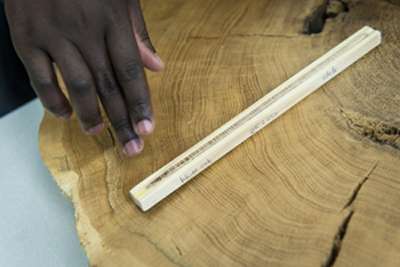Fire survivors: How do forest management strategies used to combat wildfires impact tree growth?

In an effort to combat destructive wildfires, forestry management professionals began using techniques such as thinning or methodically setting fire to dead branches and twigs that could set off a big blaze.
"Before the Smokey the Bear campaign, fires used to be an integral component of forest ecosystems in North America," explains Ohio University doctoral student Alexander Anning. "Prescribed forest fire is a relatively new management technique, occurring within the last 20 years."
Because past studies have focused on how these controlled fires have increased rates of new tree growth, Anning wondered about how the treatments impacted the trees that survived.
"There is a lack of attention to trees that remain after a controlled burn or thinning," he says. "These large trees are important for maintaining the prevailing conditions in forests."
Finding suitable specimens was easy, as Anning was able to use a site previously managed by his advisor, Brian McCarthy, professor and chair of environmental and plant biology, who was part of a nationwide study on prescribed fires in 2000.

"The project's funding ended in 2005, but the infrastructure was still there-it was a perfect fit," McCarthy says.
Anning extracted 700 straw-sized tree cores from five different species in Vinton Furnace Experimental Forest and Zaleski State Forest. Back in the laboratory, Anning used a microscope to examine ring structures within each of his core samples, dating from 1991 to 2012. Tree rings are useful for understanding the effects of the environment on tree growth, he explains, because they can provide accurate records of past growth conditions at interannual, annual, and decadal scales.
In four out of the five species investigated, rings were a similar size up until 2000, when the burning and thinning began. From then on the rings appeared bigger and healthier.
"It showed that the trees were growing at a faster rate after the burning and thinning," Anning says. "Bigger rings also mean that the trees were storing more carbon after treatment. Anything that takes carbon out of the atmosphere is important, especially as global warming becomes more of a problem."
Anning evaluated the effectiveness of three different treatment types: controlled burning, thinning, and a combination of both. When compared to the control group, chestnut oak, yellow poplar, black oak, and hickory trees all experienced varying growth rate increases depending on the treatment. White oak was the only outlier, as it did not show any appreciable increase after thinning or the combined treatment.
"Understanding growth of remaining trees is crucial in choosing the right type of treatment," Anning says. "Certain trees grow better with certain treatments. Also, you don't want to accidentally kill all the white oaks in a forest after a controlled burn."
Anning hopes his research will be used to refine the use of prescribed forest fire and thinning. He's been able to attract funding from a variety of Ohio University sources to advance this work, including the Donald Clippinger Fellowship, the Student Enhancement Award, the Graduate Student Senate Original Work Grant, and support from the Ohio Center for Ecology and Evolutionary Studies.
After completing his dissertation, he will return to his home in Ghana, where he plans to implement his research.
"Forest fires are a problem in Ghana, too," Anning says. "Now, I'll be able to go back and share my knowledge."
Provided by Ohio University















